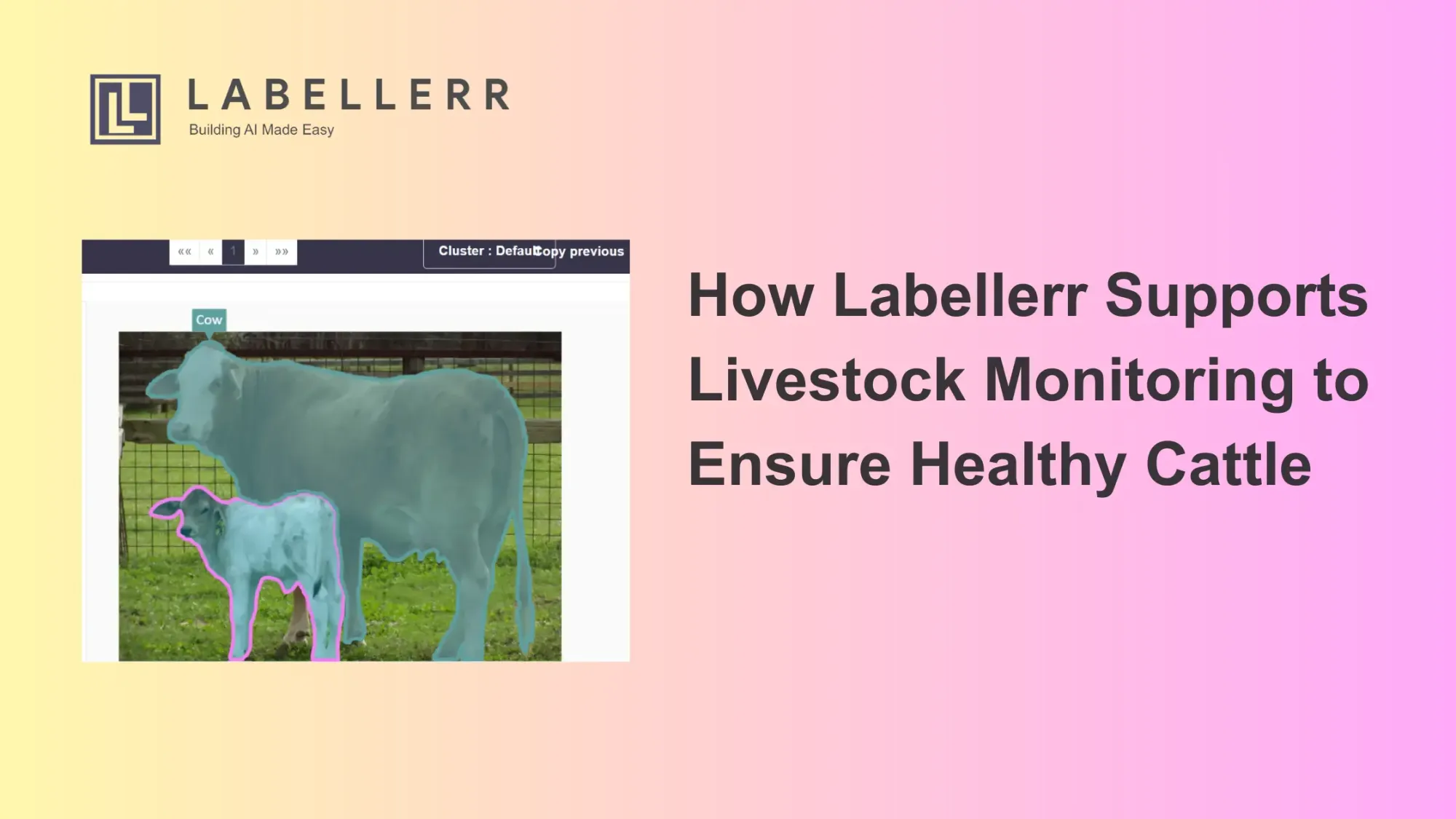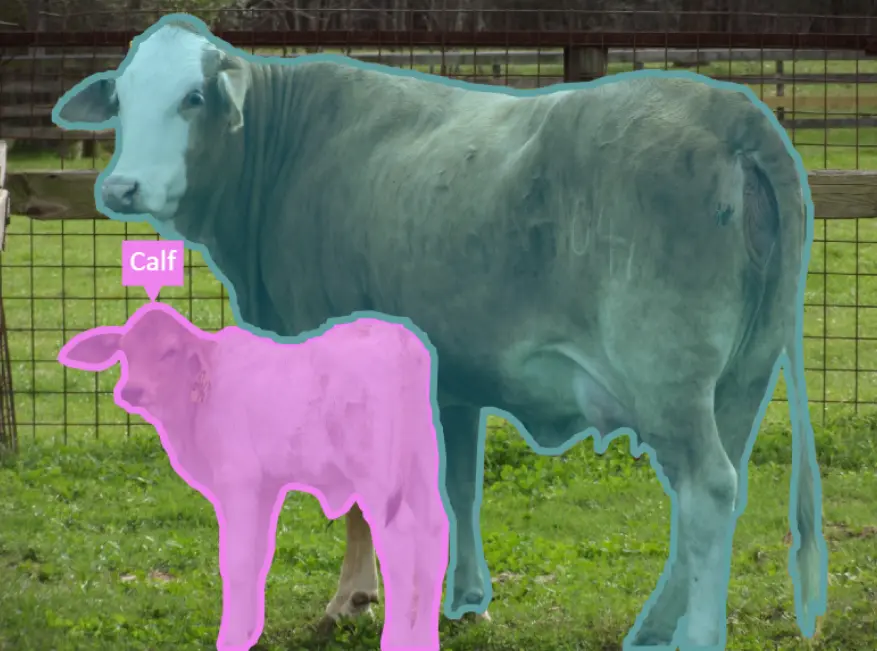Save Cost And Time For Livestock Annotation With Labellerr Using SAM

Table of Contents
- Introduction
- Challenge
- Solution: Labellerr's Role in Livestock Monitoring
- Conclusion
- Frequently Asked Questions
Introduction
In farms, taking care of animals like cows is super important.
There are special companies and smart researchers who want to help farmers keep their cattle/cows healthy and happy.
They use technology like computer vision and AI to watch over the cows.
This tech helps them spot any problems or unusual things happening with each cow, which is really helpful for the farmers.
But to do this, they need to add labels to the pictures they take of the cows. This process is called image annotation, and it's like giving the computer extra information to understand what it's seeing.
Companies and researchers are using this technology to make sure cows stay healthy and farms run smoothly.
Challenge
Monitoring the health and behavior of a large herd of cattle is a complex task for farmers, encompassing various challenges and intricacies.
Cattle such as cows, like any living creature, exhibit subtle behavioral changes that can serve as indicators of their well-being or potential health issues.
However, discerning these changes amidst the natural variability in behavior can be challenging, especially when dealing with a large number of animals.
Additionally, detecting health issues in individual cows requires keen observation and knowledge of typical behavioral patterns, as well as an understanding of the specific signs and symptoms associated with various ailments.
Traditional methods of monitoring, such as visual observation or manual health checks, are not only time-consuming but also labor-intensive, requiring significant resources in terms of manpower and time.
Moreover, these methods may not always be accurate or reliable, leading to delays in intervention and potentially exposing the animals to health risks.
Overall, the challenge lies in effectively and efficiently monitoring each cattle/cow in the herd, ensuring their well-being and promptly addressing any health concerns that arise.
Solution: Labellerr's Role in Livestock Monitoring
%20(1).gif)
To overcome these challenges, companies and researchers harness the power of annotation platforms like Labellerr.
Utilizing overhead security cameras to collect video data of the herd in real-time, they annotate this data using Labellerr's efficient tools, including bounding boxes and polygon/keypoint skeleton.
By accurately labeling the behaviors and movements of the cows/cattles, companies can build robust AI models capable of detecting anomalies and health issues promptly.
Labellerr plays a crucial role in streamlining the process of annotating video data for livestock monitoring.
Its user-friendly interface and efficient tools enable companies and researchers to annotate large volumes of video data quickly and accurately.
Watch the video below to see how Labellerr enhances livestock monitoring in action:
Read the full documentation for using SAM in an annotation workflow with Labellerr.
Below we discuss multiple factors by which Labellerr helps teams to overcome challenges.

1. Cost Savings
Labellerr proves to be a budget-friendly solution for companies and researchers engaged in livestock monitoring.
By efficiently labeling images required for developing AI models, it ensures that projects stay within budget constraints.
This cost-effective approach enables effective resource management, allowing stakeholders to focus on crucial tasks such as livestock monitoring and management.
2. Reduced Turnaround Time
Labellerr significantly reduces the time required for labeling images in livestock monitoring projects.
With its efficient labeling process, it speeds up the sorting of images needed for analyzing livestock behavior and health.
This accelerated turnaround time is crucial for promptly identifying anomalies and addressing health issues, ultimately enhancing the overall efficiency of livestock management practices.
3. Quality Control
Labellerr ensures the accuracy and reliability of labeled data in livestock monitoring applications.
Through robust quality control measures, it verifies the precision of labeled images, ensuring that datasets accurately represent the behaviors and movements of livestock.
This meticulous attention to detail is essential for training AI models to effectively detect anomalies and health issues in livestock populations.
4. Scale Up and Volume
Labellerr demonstrates exceptional scalability, allowing companies and researchers to handle large volumes of image data in livestock monitoring projects.
Its scalable infrastructure seamlessly accommodates the increased workload associated with monitoring extensive livestock populations.
This scalability ensures the smooth and efficient processing of data, facilitating a more comprehensive analysis of livestock behavior and health.
5. Custom Workflows
Labellerr's image annotation platform offers customizable workflows tailored to the unique requirements of livestock monitoring.
This customization enables stakeholders to design annotation processes that align precisely with the characteristics and behaviors of different livestock species.
By adapting workflows to specific livestock monitoring needs, Labellerr enhances the accuracy and efficiency of sorting and analyzing image data.
6. Foundation Model-Based Labeling
Leveraging advanced foundation models like CLIP, SAM, and DINO, Labellerr accelerates the labeling process in livestock monitoring applications.
These sophisticated models enhance the understanding of livestock images, enabling more accurate and efficient labeling.
By incorporating state-of-the-art technology, Labellerr improves the intelligence and effectiveness of livestock monitoring systems.
7. Active Learning-Based Labeling
Labellerr incorporates active learning capabilities, allowing the system to continuously improve its sorting and labeling capabilities based on annotated data.
This dynamic process enhances the system's proficiency over time, resulting in more accurate and adaptive livestock monitoring solutions.
By leveraging active learning, Labellerr ensures that AI models remain responsive to evolving livestock behaviors and health trends.
8. Automated QA (Quality Assurance)
Labellerr facilitates automated quality assurance processes in livestock monitoring projects, ensuring the accuracy and reliability of labeled data.
Through automated QA mechanisms, it minimizes errors and inconsistencies in labeled images, enhancing the overall reliability of AI models.
This automated QA process adds a layer of confidence to livestock monitoring systems, improving their effectiveness in identifying and addressing health issues.
9. Automated Import and Export of Data
Labellerr streamlines the data management process by automating the import and export of image data in livestock monitoring projects.
This automation reduces manual efforts and saves time in handling and organizing large datasets associated with livestock behavior and health.
By automating data import and export tasks, Labellerr enhances the efficiency of data management processes, enabling stakeholders to focus on analyzing and interpreting livestock data.
10. Collaborative Annotation Pipeline
Labellerr promotes collaboration among multiple users with different roles in the annotation process for livestock monitoring.
This collaborative approach ensures that diverse perspectives and expertise are considered in sorting and analyzing livestock image data.
By facilitating collaboration, Labellerr enhances the accuracy and comprehensiveness of livestock monitoring systems, leading to a more thorough understanding of livestock behaviors and health conditions.
Conclusion
Through the integration of Labellerr's annotation platform, companies and researchers revolutionize livestock monitoring, providing farmers with valuable insights into their herd's health and behavior.
By leveraging advanced technology and AI, they empower farmers to proactively manage the well-being of their cattle, ensuring healthier and more productive herds.
With Labellerr's support, these innovators continue to advance the field of livestock monitoring, driving positive change in the agriculture industry.
Frequently Asked Questions
1. What is a cattle health monitoring system?
A cattle health monitoring system is a technological solution that utilizes machine learning (ML) and computer vision to continuously assess the well-being of individual cows or entire herds.
These systems typically employ cameras or sensors to collect data on various aspects of cattle behavior, movement patterns, and physiological indicators such as body temperature or heart rate.
Through ML algorithms, the system analyzes this data in real-time, detecting anomalies or deviations from normal behavior that could indicate potential health issues.
By providing early detection of health problems, cattle health monitoring systems enable farmers to intervene promptly, improving overall herd management and animal welfare.
2. Can wireless sensor network based automatic health monitoring systems monitor dairy cattle?
Yes, wireless sensor network-based automatic health monitoring systems can effectively monitor dairy cattle.
These systems utilize sensors attached to the cattle or placed within their environment to gather real-time data on various health parameters such as body temperature, activity level, rumination patterns, and even feeding behavior.
This data is then transmitted wirelessly to a central monitoring system, where it is analyzed using algorithms to detect deviations from normal behavior or health indicators.
By continuously monitoring these parameters, farmers can receive early alerts about potential health issues, allowing for timely intervention and improved overall management of dairy cattle.

Simplify Your Data Annotation Workflow With Proven Strategies
.png)

